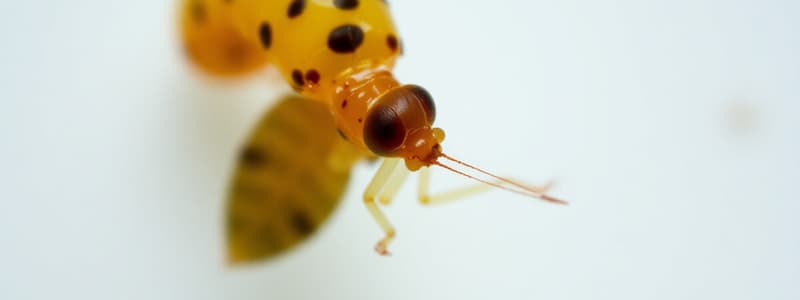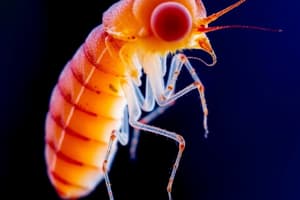Podcast
Questions and Answers
Which morphological form of Leishmania is characterized by an elongate shape with a longer flagellum and occurs only in the insect vector?
Which morphological form of Leishmania is characterized by an elongate shape with a longer flagellum and occurs only in the insect vector?
- Trypomastigote
- Epimastigote
- Amastigote
- Promastigote (correct)
Leishmania species can be morphologically distinguished from one another with ease.
Leishmania species can be morphologically distinguished from one another with ease.
False (B)
What is the primary immunological advantage that Leishmania takes advantage of in the host?
What is the primary immunological advantage that Leishmania takes advantage of in the host?
Phagolysosome
The leishmaniasis caused by L.mexicana and L.braziliensis is classified as __________ leishmaniasis.
The leishmaniasis caused by L.mexicana and L.braziliensis is classified as __________ leishmaniasis.
Which of the following statements about Leishmania reproduction is true?
Which of the following statements about Leishmania reproduction is true?
Match the types of leishmaniasis with their respective characteristics:
Match the types of leishmaniasis with their respective characteristics:
Name one genus of sand fly that acts as a vector for Leishmania.
Name one genus of sand fly that acts as a vector for Leishmania.
Leishmania relies on invading host cells to develop and reproduce.
Leishmania relies on invading host cells to develop and reproduce.
Which form of leishmaniasis is the most serious and has a 90% fatality rate if untreated?
Which form of leishmaniasis is the most serious and has a 90% fatality rate if untreated?
Death from leishmaniasis is uncommon and usually arises only from direct effects of the disease.
Death from leishmaniasis is uncommon and usually arises only from direct effects of the disease.
What is the primary immune response that indicates a person is resistant to leishmaniasis?
What is the primary immune response that indicates a person is resistant to leishmaniasis?
The delayed-type hypersensitivity (DTH) response is measured during the ______ skin test.
The delayed-type hypersensitivity (DTH) response is measured during the ______ skin test.
Match the type of leishmaniasis with its main characteristic:
Match the type of leishmaniasis with its main characteristic:
What is the primary drug used to treat leishmaniasis?
What is the primary drug used to treat leishmaniasis?
High levels of IL-10 during visceral leishmaniasis can indicate a higher risk for developing PKDL.
High levels of IL-10 during visceral leishmaniasis can indicate a higher risk for developing PKDL.
What complication can occur in some individuals who recover from visceral leishmaniasis?
What complication can occur in some individuals who recover from visceral leishmaniasis?
Infection status can be determined through serological tests by the presence of ______ in the blood.
Infection status can be determined through serological tests by the presence of ______ in the blood.
Which of the following is a common symptom of visceral leishmaniasis?
Which of the following is a common symptom of visceral leishmaniasis?
Flashcards
Leishmania
Leishmania
A genus of protozoan parasites belonging to the Kinetoplastida phylum, responsible for causing leishmaniasis.
Amastigote
Amastigote
The ovoid-shaped form of Leishmania that develops within the vertebrate host, characterized by a single nucleus and a short flagellum.
Promastigote
Promastigote
The elongated form of Leishmania that occurs only in the insect vector, characterized by a longer flagellum than the amastigote.
Leishmaniasis
Leishmaniasis
Signup and view all the flashcards
Cutaneous Leishmaniasis (CL)
Cutaneous Leishmaniasis (CL)
Signup and view all the flashcards
Mucocutaneous Leishmaniasis (MCL)
Mucocutaneous Leishmaniasis (MCL)
Signup and view all the flashcards
Phagolysosome
Phagolysosome
Signup and view all the flashcards
Anthroponotic Transmission
Anthroponotic Transmission
Signup and view all the flashcards
Ulcerative Leishmaniasis
Ulcerative Leishmaniasis
Signup and view all the flashcards
Non-ulcerative Leishmaniasis
Non-ulcerative Leishmaniasis
Signup and view all the flashcards
Visceral Leishmaniasis (Kala-azar)
Visceral Leishmaniasis (Kala-azar)
Signup and view all the flashcards
Post Kala-azar Dermal Leishmaniasis (PKDL)
Post Kala-azar Dermal Leishmaniasis (PKDL)
Signup and view all the flashcards
Lipophosphoglycan (LPG) of Leishmania
Lipophosphoglycan (LPG) of Leishmania
Signup and view all the flashcards
Strong Th1 Response
Strong Th1 Response
Signup and view all the flashcards
Strong Th2 Response
Strong Th2 Response
Signup and view all the flashcards
Leishmanin Skin Test (LST)
Leishmanin Skin Test (LST)
Signup and view all the flashcards
Direct Agglutination Test (DAT)
Direct Agglutination Test (DAT)
Signup and view all the flashcards
K39 Test
K39 Test
Signup and view all the flashcards
Study Notes
Leishmania Overview
- Phylum: Kinetoplastida
- Four morphological forms: amastigote, promastigote, epimastigote, trypomastigote
- Amastigote: ovoid, vertebrate host, single nucleus, short flagellum
- Promastigote: elongate, insect vector, longer flagellum than amastigote
- Epimastigote: kinetoplast posterior to nucleus, undulating membrane present
- Trypomastigote: various forms, longer body, undulating membrane, kinetoplast anterior to nucleus
Leishmania Life Cycle
- Endemic to tropical and subtropical regions
- Two genera of sand fly vectors:
- Phlebotomus (Eastern hemisphere)
- Lutzomyia (Western hemisphere)
- Sand flies feed on blood and lymph.
- Difficult to distinguish Leishmania species morphologically.
- Causes leishmaniasis.
- Amastigote transforms into promastigote in the fly gut, multiplying asexually, then becoming metacyclic promastigotes.
- Recent evidence suggests sexual reproduction in fly gut.
- Leishmania-infected sand flies have midgut valve dysfunction, causing regurgitation of blood containing promastigotes onto the host wound.
- Leishmania relies on host cell phagocytic activity, particularly of the phagolysosome for survival.
- Suppresses generation of reactive oxygen species (ROS).
Leishmaniasis Types and Manifestations
- Three clinically distinguishable types:
-
Cutaneous Leishmaniasis (CL):
- Self-healing, dry skin lesions (papules, nodules, ulcers).
- New World (e.g., L. mexicana, L. braziliensis), Old World (e.g., L. tropica, L. major).
- Old World anthroponotic, New World sylvatic.
- May lead to co-infections.
- Treated with pentavalent antimony if disseminated cutaneous leishmaniasis (DCL)
- Recidivans (recurrent CL) most parasites eliminated, but infection not cured.
-
Mucocutaneous Leishmaniasis (MCL):
- Caused by L. braziliensis and L. tropica.
- Often develops from CL.
- Two forms: ulcerative (rapid mutilation of mucous membranes) and non-ulcerative (edema and hypertrophy).
- Treated with amphotericin B or antimony drugs.
-
Visceral Leishmaniasis (kala-azar):
- Most serious form, potentially asymptomatic.
- 90% fatality if untreated, infects reticuloendothelial system.
- Symptoms include fever, weight loss, hepatosplenomegaly, anemia, enlarged lymph nodes.
- Complications: Post kala-azar dermal leishmaniasis (PKDL).
- PKDL mainly self-healing in Africa, but not in India
-
Lipophosphoglycan (LPG)
- Protects Leishmania from digestive activities in the fly's gut.
- Elongates during development in the fly.
- Protects against macrophage enzymes, host immune responses, and natural killer T (NKT) cell recognition.
- Binds to host macrophage receptors for phagocytosis.
- Inhibits ROS.
Host Immune Response
- Strong Th1 response: resistant, localized infections.
- Th1 cells release INF-γ, enhances macrophage killing, promoting healing and activating cytotoxic T cells.
- Strong Th2 response: susceptible to DCL or VL.
- Th1 is intracellular, Th2 is extracellular; Th1 is cell-mediated, Th2 is humoral (body fluids).
Diagnosis of Leishmaniasis
- Cutaneous Leishmaniasis: Specimen collected from lesion edge; biopsy, incision; in vivo culture (1 week), hamster culture (2-3 months)
- Visceral Leishmaniasis: Aspirates from bone marrow, lymph nodes, spleen (higher parasitemia).
- Serological tests: Detect antibodies (e.g., DAT - detection of antibodies to Leishmania); K39 test uses serum.
- Leishmanin skin test (LST): Measures delayed-type hypersensitivity (DTH) response to Leishmania.
Studying That Suits You
Use AI to generate personalized quizzes and flashcards to suit your learning preferences.




